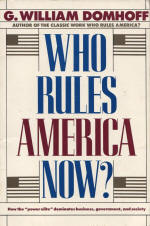|
Who Rules America
Now ?
THE CONCENTRATION
OF STOCK OWNERSHIP (pages 57 - 59)
It is often emphasized in advertising campaigns
that there are many millions of stockholders in
the United States. In the 1950s the New York
Stock Exchange publicized the large number of
stockholders by calling the system "people's
capitalism," and in the 1960s and 1970s
individual companies ran magazine and television
advertising that included information on their
tens of thousands of stockholders.
|
 |
During the late 1970s the
stocks owned by pension funds were sometimes included in
these claims, swelling the number of worker-owners
higher than ever before. Management consultant Peter
Drucker went so far as to say that the "unseen
revolution" of pension fund socialism had brought to
America "a more radical shift in ownership than Soviet
communism," a claim that was pointed out to be quite
inaccurate by economists and lawyers. A pension fund is
only a promise to pay a certain amount of money to
people of a certain age after a certain number of years
of work, not ownership of stock by workers by which they
can reap the benefit of any appreciation in its value or
exercise its voting power to affect corporate policy.
Whatever the actual number of stockholders, systematic
studies show that most of them own very little stock.
Robert Lampman's studies using the estate-multiplier
method for six different years between 1922 and 1953
estimated that the top 1 percent of all adults held from
61.5 to 76 percent of all privately held stock. Using
the same method, James D. Smith found the percentage to
be 51 percent for the top 1 percent in 1969. Smith's
work also demonstrates that stock is even more
dramatically concentrated within the hands of a few
thousand major owners. One-twentieth of 1 percent of
American adults have one-fifth of the corporate stock,
and 0.2 percent have one-third of it. Sociologist
Maurice Zeitlin makes this concentration more graphic by
pointing out that "the Rose Bowl's 104,696 seats would
still be half empty if only every American who owns $1
million or more in corporate stock came to cheer."
Research employing other methods leads to comparable
results. A study using stock portfolios obtained from a
sample of wealthy individuals came to the conclusion
that just 0.2 percent of all "spending units" (families,
generally speaking) held 65 to 71 percent of the stock
in the early 1950s. This figure is very close to
Lampman's estimate of 76 percent for the top 1 percent
The household survey for 1962 that was cited in the
previous chapter estimated that the top 1 percent of
wealth-holders owned 62 percent of all publicly held
corporate stock; the top 5 percent had 86 percent and
the richest 20 percent held 97 percent. Similarly, a
study utilizing random samples of individual income tax
returns obtained from the Internal Revenue Service for
1960 and 1971 found that the 1 percent of families with
the highest income controlled 51 percent of the market
value of all stock owned by families. There was
virtually no change in concentration over the
eleven-year period.'
These different estimates vary somewhat due to the fact
they employ different data bases, and they may
underestimate the degree of concentration because of the
difficulty in obtaining solid information. But they all
make the important point that the distribution of stock
ownership is even more highly concentrated than the
wealth distribution in general. Among all types of
assets studied by Lampman and others, only the ownership
of tax-free state and local bonds is more concentrated
in the hands of the rich than corporate stock. In terms
of privately held stock, Mills seems to be correct that
"at the very most, 0.2% or 0.3% of the adult population
own the bulk, the pay-off shares, of the corporate
world:
However, this concentration of stock ownership within
the upper class in general does not answer the question
of corporate control satisfactorily. It may be that the
stock is widely dispersed within the class as a whole,
leading to a situation where no one family or group of
investors could use its ownership of stock to influence
or replace management. It therefore becomes necessary to
consider the question of ownership and control more
closely, for what has been demonstrated so far only
shows that upper-class ownership of corporate stock may
act as a general constraint upon top executives.
|